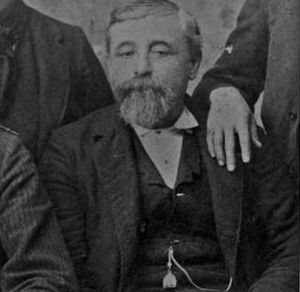Benjamin Franklin Smallwood facts for kids
Quick facts for kids
Benjamin Franklin Smallwood
|
|
|---|---|
 |
|
| Choctaw Nation leader | |
| Preceded by | Thompson McKinney |
| Succeeded by | Wilson Nathaniel Jones |
| Personal details | |
| Born | 1829 Present-day Mississippi |
| Died | December 15, 1891 Lehigh, Indian Territory |
| Political party | National Party |
| Spouses | Annie Burney Abbie James |
| Parents | William Smallwood Mary (LeFlore) Smallwood |
| Education | attended Spencer Academy |
| Known for | Principal Chief of Choctaw Nation from 1888 to 1890 |
Benjamin Franklin Smallwood (born 1829 – died December 15, 1891) was an important leader of the Choctaw Nation. He served as their Principal Chief from 1888 to 1890. Smallwood worked in public office for the Choctaw Nation for many years, starting in 1847. The only time he wasn't in office was when he served as an officer during the Civil War.
Contents
Early Life and Education
Benjamin Franklin Smallwood was born in 1829 in the Choctaw Nation, which was then in Mississippi. His parents were William and Mary (LeFore) Smallwood. When he was a young child, his family moved to Indian Territory. This move was part of the Choctaw Trail of Tears, a difficult journey where many Native American people were forced to leave their homes.
As a boy, Smallwood went to Spencer Academy. This school was located in the Choctaw Nation and helped educate young Choctaw people.
A Leader for the Choctaw Nation
Smallwood started his career in public service in 1847. He first worked as a ranger in Kiamichi County. In the same year, he became a representative in the Choctaw Council. This was like being a member of a parliament or congress.
He later became the speaker of the lower house. He also served as a delegate to Washington, D.C.. In this role, he helped make important agreements between the Choctaw Nation and the United States government.
Running for Principal Chief
In 1886, Smallwood ran for Principal Chief. He was the candidate for the National Party. However, he lost to Thompson McKinney, who was from the Progressive Party.
Two years later, in 1888, he ran for Principal Chief again. This time, he was up against Wilson Nathaniel Jones. Smallwood had been a representative for a long time, so he was very popular. He won the election, even though the Progressive Party won most of the seats in the Choctaw Council. Because the Chief and the Council were from different political parties, it was hard for Smallwood to get many things done during his time in office.
Protecting Choctaw Independence
Smallwood cared deeply about keeping the Choctaw Nation independent. He wanted to stop the U.S. Government from interfering in their affairs. He was worried when a federal court was set up in Indian Territory. He also disagreed with a U.S. law that allowed people to appeal Choctaw court decisions to the U.S. government.
He also didn't want towns started by white settlers to become official. These towns, like Krebs and Lehigh, didn't have official status. This meant they lacked basic services like water, sewer systems, and fire or police protection.
Smallwood's home, the Benjamin Franklin Smallwood House, was an important meeting place. Choctaw leaders and even members of the U.S. Congress met there. Smallwood preferred to meet U.S. government representatives at his own house.
In 1888, the U.S. Government made a payment to the Choctaw Nation. This money was for the Leased District, land that the Choctaw had given to the U.S. in 1855. Smallwood called a special meeting of the Council. They decided to give out the money without a full review.
Smallwood wanted to make Choctaw schools better and bigger. But because of the political disagreements, he couldn't make much progress. However, after he left office, the new Chief, Wilson Nathaniel Jones, and the Council did follow his ideas and added more schools.
His Time in the Civil War
During the United States Civil War, Benjamin Franklin Smallwood served as a Captain. He was part of the 2nd Choctaw Regiment in the Confederate Army.
Business and Home Life
Smallwood was also a businessman. He opened his first store in Kiamichi County in 1862. The next year, he moved to Lehigh. He owned a farm near Lehigh where he raised cattle. He also ran a dry goods store in town.
His home on the ranch was a sandstone house built in 1875. This house is known as the Benjamin Franklin Smallwood House. It was recognized as a historic place in 1982.
Later Years
After losing his bid for reelection in 1890, Smallwood retired. He went back to his home near Lehigh. He passed away there on December 15, 1891.
Personal Life
In 1849, Benjamin Franklin Smallwood married Annie Burney. She was a Chickasaw woman. Annie passed away during the Civil War. Smallwood later married Abbie James.

